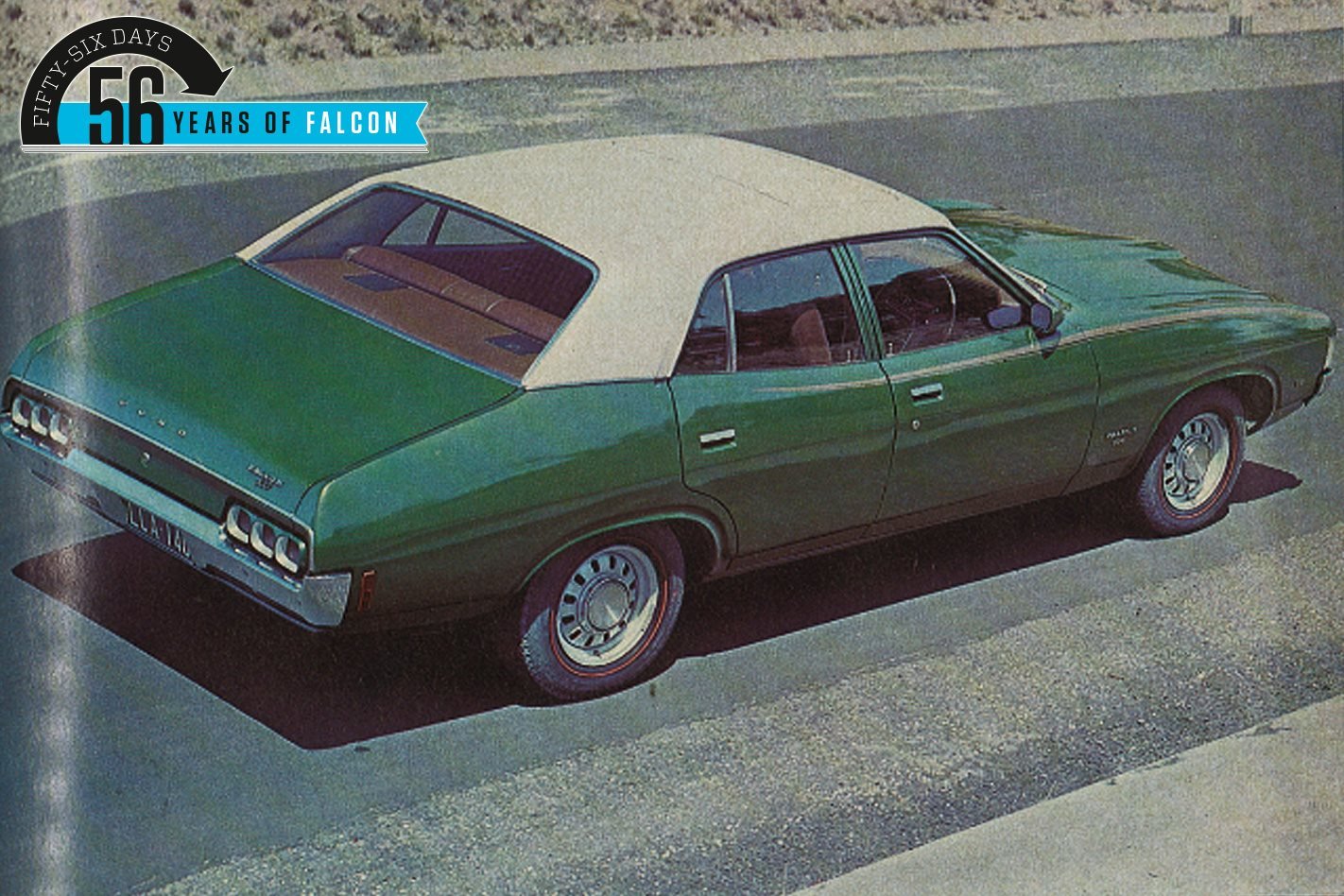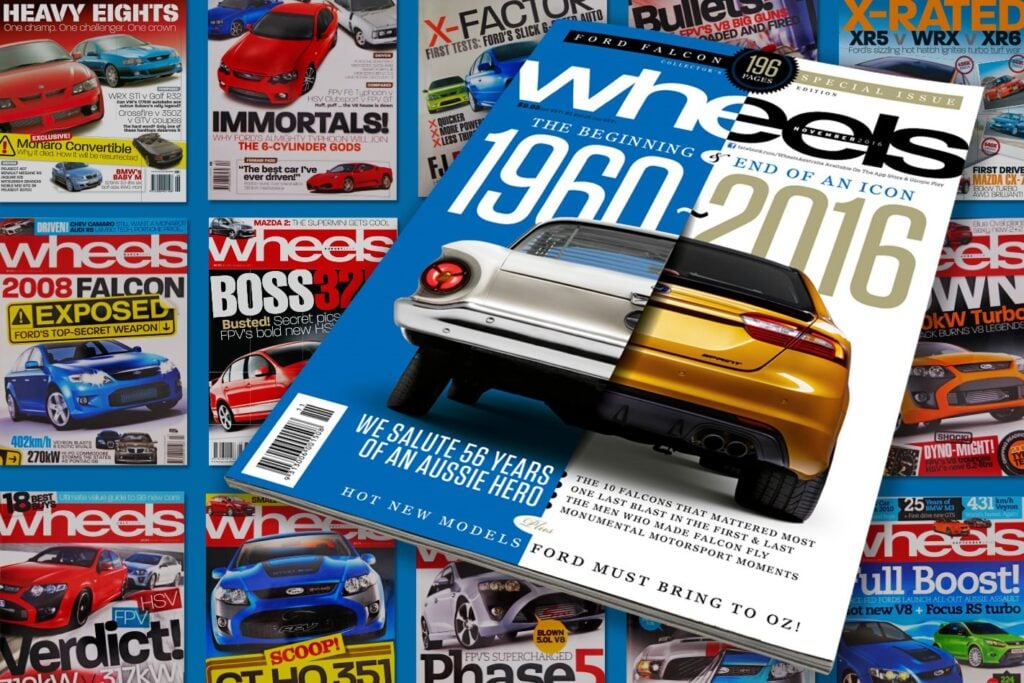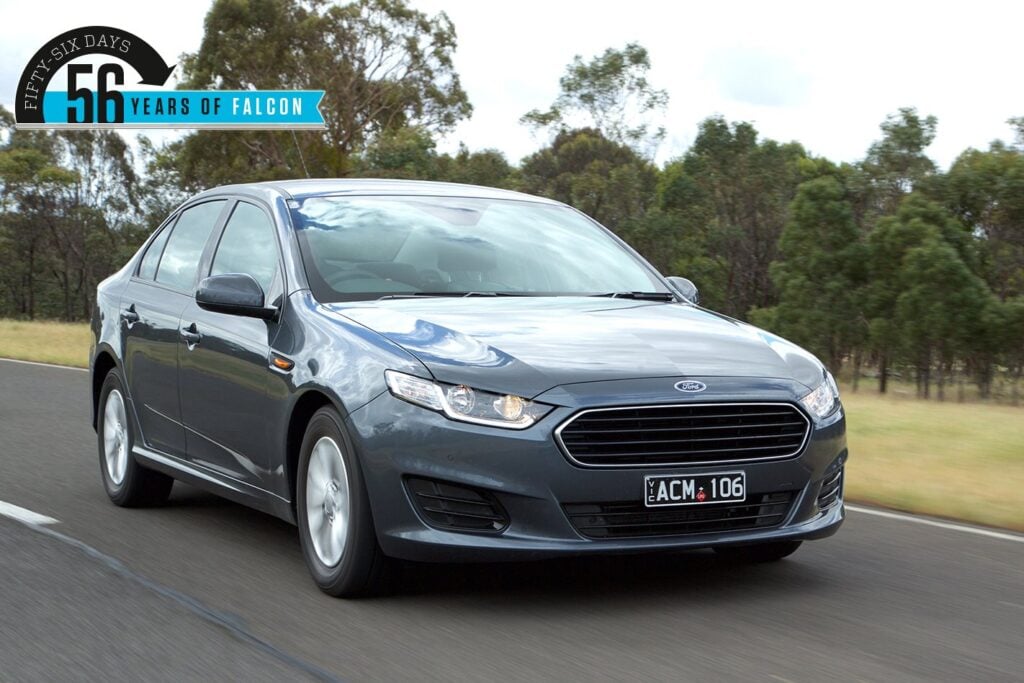We get first drive: NEW XA FALCON
With all the good points of the old car and a few new ones thrown in, Ford’s new one continues the “great road car” theme.
First published in the April 1972 issue of Wheels magazine, Australia’s best car mag since 1953.
ONCE YOU’VE SEEN the XA’s styling and agreed it is shorter than the pics indicate, but still squat and purposeful with a very Ford look about it the driving position is what really impresses.
The thin-rimmed steering wheel is almost at arm’s length, fairly low down and raked just off vertical. The bucket seats on the GS we drove are tall with plenty of lateral support all the way up the squab and the cushion is firm with more than enough padding for the thighs.
The instruments in the vast wraparound facia are very easy to read and all the minor controls are within arm’s length. The dashboard is all new and has a very plastic look and feel but this doesn’t prevent it from achieving an imposing and impressive air.
Visibility is excellent with thin pillars and a lack of quarter vents. It is not quite as good as the HQ Holden because the windscreen is more sharply raked back and the side windows are rather shallow but it is a vast improvement over the XY. At the rear, and in common with the Valiant and Holden, it is impossible to see the tail so parking will depend entirely on good judgment or the old touch method.
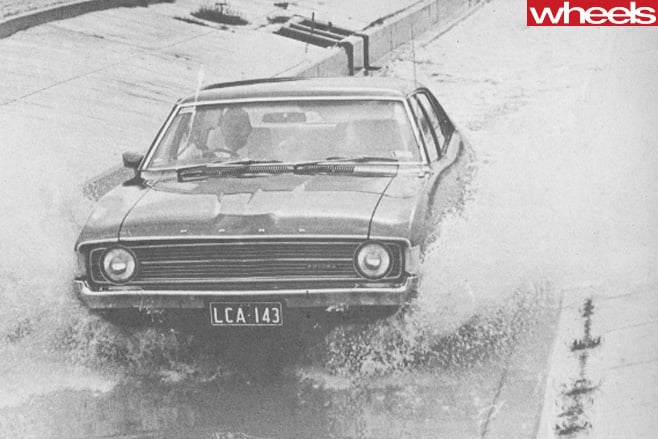
The choke is low down beside the steering column on the left. A battery of warning lights is to the left of the two main instruments. Both flowthrough vents and they have almost infinitely adjustable outlets are operated independently from in front of the driver.
The steering lock/ignition — it locks the car in reverse, as well, on column shift versions — is on the left of the column and facing the driver so there is no need to search for it.
On bucket seat models, with the optional GS pack, a very deep luggage bin between the seats doubles up as an armrest. In front of this a console continues forward to take in the floor-mounted gear lever and also provide an open tray for minor luggage.
On the road the Falcon feels much as before with light, reasonably direct steering and a taut, firm grip on the road. The ride is good without the float or body roll of the HQ Holden but also without that car’s ultimate smoothness.
Corrugations still send the tail bouncing out but this tendency has been reduced compared with the XY.
The brakes, clutch and engine – the car we drove was a Futura 250 four-speed – feel very much as before with a light, slightly spongy brake pedal and short clutch throws. The gear change seems to have longer throws between ratios but the change is excellent, on a three-speed column change model we tried briefly the shift was shorter and more positive than we remember of the XY.
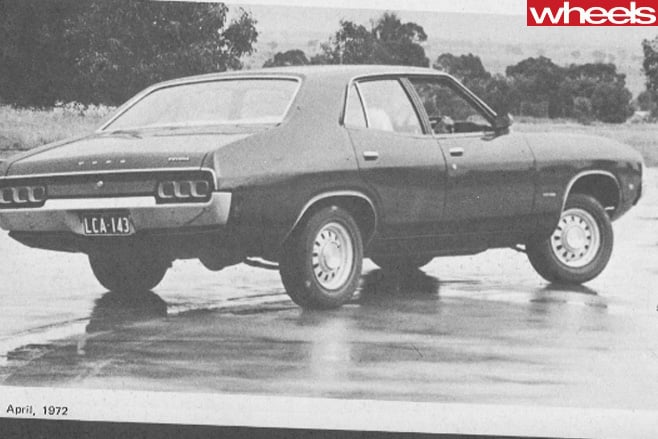
Like previous Falcons the XA is very easy to drive, it requires no special technique, being one of those models in which a driver can sit behind the wheel and immediately feel at home.
Rear seat passengers, too, are going to be more comfortable. The rear seat has been improved with a deeper cushion and taller squab. Knee and legroom seem better, probably because the front seats are thinner, although the official Ford figures indicate leg room is down. Certainly there’s not much head room for a tall person.
Plenty of customers will welcome Ford’s decision to retain the spare wheel in the floor of the petrol tank rather than having it out in the boot where it consumes plenty of space. The boot itself is deeper than before and the petrol filler pipe takes up much less room.
On the low mileage car we drove it was impossible to take any performance figures but since the engines are identical and weights have risen by a matter of a few lb only, performance should be very close to XY.
So Ford’s XA Falcon comes out of a short impressions run very well. It still has the tight, solid feel, which did so much to make the XW and XY models pleasant to drive. With its improved handling, sensible yet imposing interior and the new styling the XA has plenty going for it.
SLEEK FALCONS SWOOP IN!
FORD’S NEW XA Falcon is undoubtedly the most important model the company has ever released. Its bold new lines could carry Ford to sales leadership in Australia in the present decade.
At a time when the Holden and Valiant sedans are suffering in the marketplace Ford is hoping its new models will represent an appealing half-way house between the big car look of the Valiant and the smaller, chunky appearance of the HQ Holdens.
The XA is all Australian. It was conceived, engineered and styled locally and uses local VS engines for the first time on an Australian Ford. Simply stated, the XA could be said to be just a new body on the old mechanicals. But there has been a great deal of refinement and modification made to improve handling, quietness and comfort.
It is the styling that is all important – regardless of what lies under the skin it is appearance which sells cars to most buyers and the Falcon seems to have achieved just the right compromise.
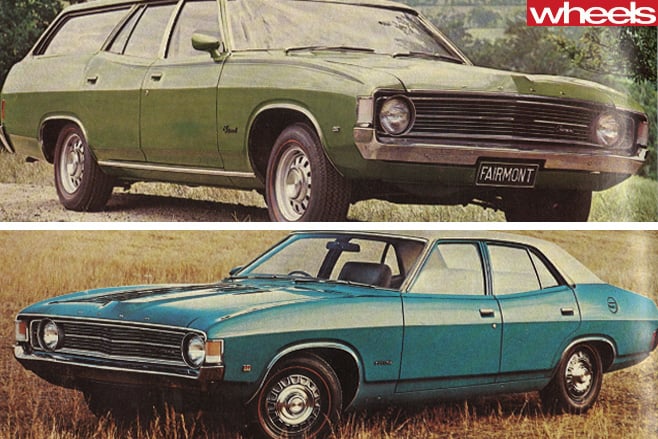
But the Falcon has a lower, wider appearance and that’s what counts. The Holden looks smaller than it is, the Valiant bigger, the Falcon seems just right and yet it has the same practical features that make the HQ body so sensible.
Nobody could pick the styling for anything but a Ford. It still looks like a Falcon, a new Falcon, but still a Falcon.
There is plenty of Cortina TC influence, some Torino and not a little Capri but it has all been welded into one unified, if bland package that goes close to being the best looking Ford sedan we’ve seen in years.
Ford has obviously kept the car as middle of the road as possible. It’s a policy that will probably succeed.
Dimensionally, there is little difference between the new XA and the XY. It is 1. 9 inches longer, 1.2 inches wider and 1.9 inches lower. A wider track of 60.5 inches (up 1.6 inches), at the front and 60.6 inches at the rear (up 1.5 inches), contributes to improved handling and stability. Even one John Arthur Brabham was impressed after a short drive at the Ford proving ground.
Some internal dimensions have also been increased, such as shoulder and hip room but both front and rear leg room are down very slightly over the old cars. Headroom, too, has suffered a little in the general lowering of the car.
Ford has gone all out with the station wagons and built them on the Fairlane’s 116 inch wheelbase for a total overall length of 16 ft 4.1 in., up 5.8 inches over the previous model.
That wheelbase is two inches longer than Holden’s long wheelbase wagon and 6.1 inches longer overall. Valiant’s wagon is still built on the sedan’s 111 inch wheelbase but its overall length is 2.3 inches longer than the Falcon which is a good indication of the rear overhang it carries behind. With the tailgate down, the maximum cargo length of the Falcon has grown 4. 5 inches to 109.2 inches and there have been similar increases elsewhere. Load capacity has risen from 75.5 cubic feet to 82.6 cubic feet.
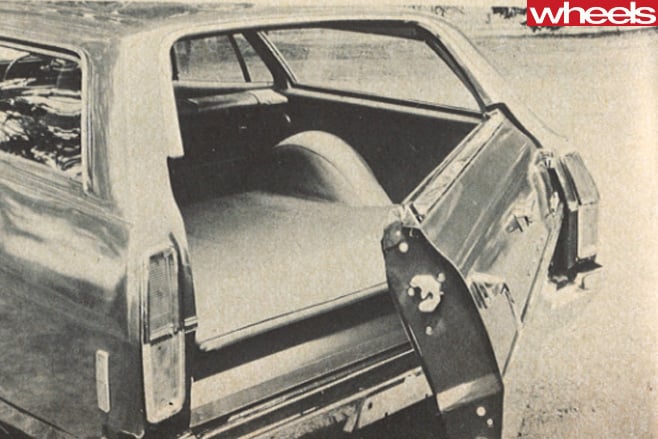
The wagon is 1.5 inches higher than the sedan and this is reflected in the ground clearance which, at 6 .4 inches, is one inch higher than the sedans. GMH reduced the ground clearance on the HQs to 5.6 inches and Ford has gone even lower to 5.4 inches – which won’t please country buyers.
Fuel tank capacity has risen by over one gallon to 17.5 gallons on the sedan and from 13.6 gallons to 16.0 gallons on the station wagon. Weight, too, has gone up but not by as much as we expected.
The base sedan has gone from 3003 lb to 3017 and the wagon from 3163 to 3225 lb.
Apart from these changes, brought about because of the completely new body, the Falcon mechanicals are largely unchanged. The 302 and the two-barrel 351 engines are now locally manufactured but this has made little difference to their respective power ratings – the 302 goes from 220 bhp at 4600 rpm to 240 bhp at 5000 rpm and the 351 from 250 bhp at 4600 to 260 bhp at 4600 rpm. The 351 GT engine is still fully imported and is rated at 300 bhp at 5400 rpm. There is a Phase IV HO but it’s at least three months away.
The range of three six cylinder engines – 200, 250 and 250 2V – is unchanged.
Transmissions and final drive ratios are also unchanged. Suspensions have been fiddled to improve the ride and quietness but are essentially the same and continue with MacPherson struts at the front and semi-elliptic leaf springs at the rear. The GT gets a rear anti-tramp radius bar.
The standard steering is as before with recirculating ball gear and a ratio of 20.0:1. The GT’s ratio is quicker at 16.0:1 but Ford follows the GMH lead in adopting a variable ratio , for the optional power steering, which varies between 11.0:1 and 17.5: 1. The turning circle of 39.4 ft is bigger than before and reflects the increase in track.
Disc brakes are standard on the Futura, Fairmont and GT and all V8 models, but drums are continued on the base Falcon, which more than ever is a fleet owner’s vehicle – it doesn’t even rate a mention in the Falcon sales brochure – and the 500.
Inside, the Falcon takes on an air of vastness with a very American dashboard shaped in the fashion of the current Galaxie. The instruments and control panel wrap around in front of the driver. Two large circular dials are mounted low down directly in front of the steering wheel. On the GT and optional GS package there are four minor gauges above the speedometer and tachometer which is most unusual. A steering column lock which automatically locks the transmission, steering and ignition is standard and is easily reached on the right of the steering column.
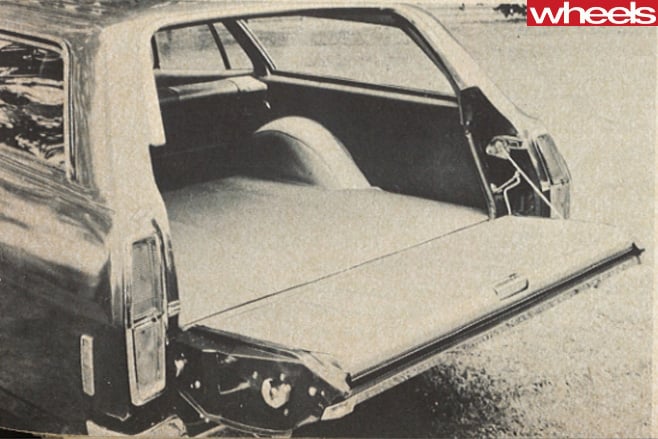
The entire interior is well laid out and very impressive on the eye. The seats have high backs to fit in with the new safety requirements and visibility is excellent with thin windscreen and central pillars. The buckets, standard on Fairmont and GT, optional on the others, return to an infinitely adjustable squab so the driving position with these seats should be excellent.
A rundown of the four major models gives an indication of the equipment supplied as standard:
Falcon 500: Runs the base 200 cid, 130 bhp engine with three-speed manual transmission and drum brakes.
Futura: Moves up one step with the 155 bhp version of the 250 cid engine and three-speed manual transmission. Disc brakes are standard. Compared with 500 it gets central armrests and generally improved trim and equipment.
Fairmont: The 155 bhp 250 cid engine and automatic transmission are standard. So are chrome window surrounds, door sill mouldings, wheel arch and rocker panel mouldings and full wheel trims, bucket seats, carpets, special reading lamps and sound deadening.
GT: Continues its role as the high performance touring car with lowered suspension, wide sports wheels, 300 bhp, 351 cid engine with four speed gearbox and quartz iodine driving lights.
A complete range of instruments including a clock is standard and the interior is finished to the same standard as the Fairmont.
The optional GS pack delivers a sweeping side stripe and sports wheels and the GT instruments and steering wheel. It is optional on 500, Futura and Fairmont, even in station wagon form.
Other options include bucket seats, sports console with armrest, four-speed gearbox or T-bar automatic, stereo/radio /tape player, vinyl roof (in a choice of five colors) or sliding sunroof and the complete range of engines.
Electric side windows are optional for the first time on a Falcon and there is a master control on the driver’s door which locks out the other individual controls.
Built-in air conditioning is optional only with the 250 six and V8 engines.
Cloth seat inserts are available. Adjustable spoilers front and rear are optional on the GT.
For Ford, the XA shows promise of being the most exciting prospect in years. The sedan range alone has an increased number of options throw in the coupes, due in the second half of this year, and you have a range of cars that spells big trouble for the opposition.
And the mechanicals are well proven so there should be no difficulties in this area.
Fairlane has been delayed one month and later in the year there will be a two-door version to consolidate further its lead in the prestige market.
Ford’s overall strategy is obvious. The new Falcon/Fairlane range will blanket the medium and upper/medium markets while the new Cortina sixes will take care of the lower end – although inevitably they will steal sales from the Falcons.
On the competition front a special Cortina 250 has been lapping the You-Yangs proving ground at up to 138 mph. It is specifically designed to beat the XU-1s at Bathurst while the new Phase IV goes for outright. So 1972 might be the year we all watch the Fords go by.
Check out Wheels Archive online now for other great Ford Falcon features and more from decades past!
Simply log in here using your existing MagShop account or create a FREE account and select this article from the homepage.
Don’t have a MagShop account?

Have a MagShop account?


